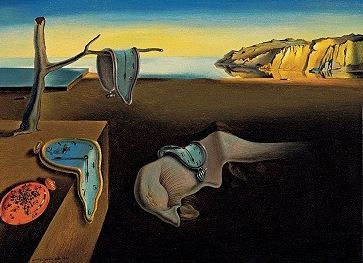The Persistence of Memory is an oil-on-canvas painting created by Salvador Dali in 1932. The painting serves as one of the most prominent artworks in Surrealist art, and because of its vague-yet-powerful imagery, the meaning and symbolism of the painting are still being debated until today. Created during the peak of Surrealism, Salvador Dali emphasizes the use of the said art form by incorporating and depicting “uncanny” objects in the painting, such as the melting clocks and the almost unrecognizable anthropomorphic figure at the middle portion of the artwork. To know more about the fascinating painting, here are the interesting origins of The Persistence of Memory.
Origins and Interpretations
In terms of the painting’s origins, no one actually knows where Salvador Dali painted it and how it came to be, but there is a theory about its inspiration. The theory of its origins is that Dali dreamt of the imagery on one particular night, and when he woke up, he immediately painted what he saw in his dreams. Some people also believe that Dali saw the imagery when he was hallucinating after taking hallucinogenic drugs. Regardless of the several theories surrounding its origins, Salvador Dali was firm to say that it was painted in 1931.
The Persistence of Memory was first showcased at the Julien Levy Gallery in 1932, and it has been in possession of the Museum of Modern Art (MoMA) in New York since 1934 after being given as a gift by an anonymous donor.
The painting is particularly famous for the three melting clocks that are scattered in the painting, The first melting clock is hanging on a branch of a dead tree, the second clock is placed on a table-like object at the lower-left corner of the painting, and the third clock is located on top of an anthropomorphic figure at the middle. Although some call them “melting clocks,” they are actually pocket watches but are much bigger than the normal ones.
The melting clocks, according to art interpreters, are supposed to represent the relativity of space and time. In simple interpretation, the clocks symbolize the futility of time invented by man in the vast space, since man-made time can only be applied on Earth and not in space. According to Albert Einstein in his Theory of Relativity, time is relative, which means that the time applied to you and other people are set by frames of reference created by us. In a sense, it could also be stated that time is an illusion, as no one can actually determine the time in the observable universe, and we only created or “imagined” time to determine our past, present, and future. The Persistence of Time was painted during the time when Salvador Dali was delving deeper into science, which could also explain why he added the symbolism of time in the artwork.
On the other hand, the melting clocks could also represent the futility of time in dreams. Whenever we dream, we don’t actually have a concept of time, hence the reason why the events in our dreams would often jump from day to night or from one day to another even if we are only sleeping for less or more than seven hours.
The anthropomorphic figure in the middle of the figure is believed to represent the people we usually see in dreams. When we try to describe the strangers we see in our dreams, we would often be clueless as to their features, traits, or physical attributes. The unrecognizable figures in our dreams are greatly represented by the anthropomorphic figure in the painting, which is also almost recognizable save for its big eye and eyelashes located to its left. The figure could also be interpreted to be the dreamer, who has no control over his or her dreams, and the dream that the dreamer is experiencing forces him or her to melt along with the clocks.
Although there are three melting clocks, there is only one solid clock located in the lower-left corner of the painting. This solid clock, which is orange in color and has multiple ants at its top, is supposed to represent the decay of time and death, hence the reason why it is infested with ants. There are a few people who believe that the clock remains closed and solid because it is also representing humans trying to get a hold of time (or still believe in the concept of time) despite its futility in the vast universe.
Even though there are many interpretations that arose for The Persistence of Time, Salvador Dali refused to give its meaning until the end of his life. Whenever he was asked about the meaning and symbolism of the painting, Dali would often answer it in a joking manner. Because of his refusal to reveal the right interpretation for the painting, it must have been Dali’s intention for the painting to force people to find meaning in it and formulate their own interpretations.


